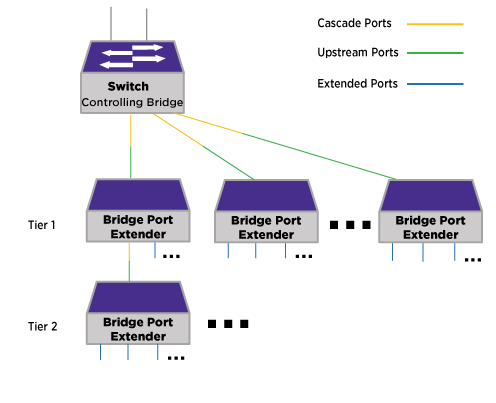VPEX Switching Architecture
Virtual Port Extender (VPEX)
Description
The following figure shows the VPEX switching architecture, based on the IEEE 802.1BR
specification, comprising one or two controlling bridges (CBs), and one or more
bridge port extenders (BPEs) (see Bridge Port Extender (BPE) Description). In this document, BPEs are V400 Virtual Port Extenders, and CBs are ExtremeXOS
switches.
In this architecture, ports on the CB or BPEs connecting to BPEs are termed cascade ports, while
corresponding ports on BPEs connecting them to the CB or upstream BPEs are termed upstream ports. Ports from
the BPEs connected to the rest of the network are termed extended ports.
Bridge Port Extender (BPE)
Description
Bridge port extenders (BPEs) are devices that do not fully process
packets, nor make forwarding or filtering decisions. Instead, BPEs simply receive
packets from extended ports and forward packets towards the upstream controlling
bridge for L2/L3 processing.

Note
Due to the lack of
extensive processing performed on BPEs, traffic entering on a BPE extended port that
is destined to exit another extended port on the same BPE is forwarded to the
controlling bridge (CB), and then forwarded back to the BPE, rather than processed
exclusively within the BPE.
Important Terminology
The following terms are important for understanding virtual port extenders (VPEX):
- Bridge Port Extenders
(BPEs)— Devices that do not fully process packets, nor make
forwarding or filtering decisions. Instead, BPEs simply receive packets from
extended ports and forward packets towards the upstream controlling bridge
for L2/L3 processing.
- Cascade port—A port
on a controlling bridge or BPE that connects to an upstream port.
- Controlling Bridge
(CB)—In this context, a switch that provides full L2/L3 packet
processing and filtering functionality for cascade ports and extended ports.
CBs discover their BPEs through LLDP. The CB, with its managed BPEs, acts as
like a single switch, but with many more ports.
- E-Channel-ID
(E-CID)—Identifies the BPE destination port (or port-list for multicast
E-CID).
- E-Tag—A tag header
immediately following the 802.1BR EtherType (0x893F) that contains the
E-CID; this tag is only resident between bridge port extenders and
controlling bridge devices.
- Edge Control Protocol
(ECP)—Provides basic acknowledgment and re-transmission mechanism
for reliable delivery; used for PE-CSP transmission.
- Extended bridge—A
controlling bridge combined with one or more BPEs. The extended bridge is
managed as a single entity.
- Extended ports—Ports
from BPEs connected to the rest of the network. Extended ports do not
operate as a Cascade Port or an Upstream port.
- Port Extender Control and
Status Protocol (PE-CSP)—Simple command/response protocol that
allows a controlling bridge to discover, program, and obtain status from a
bridge port extender.
- Upstream port—Port on
a BPE that connects to a cascade port.
- Virtual Port Extender
(VPEX)—A switching architecture based on the IEEE 802.1BR
specification, comprising a CB, and one or more BPEs.
For more in-depth information about VPEX switching architecture, see the ExtremeXOS User Guide.

